#export data Costa Rica
Explore tagged Tumblr posts
Text
Costa Rica Trade Data: 2025 Power for Traders?
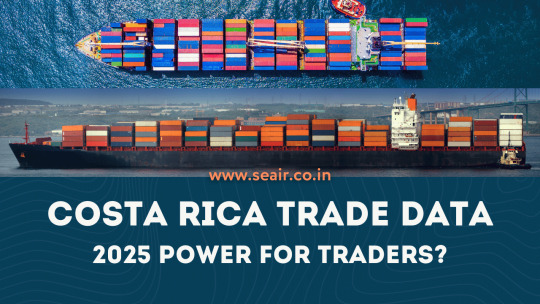
Introduction
In the intricate web of global commerce, a deep understanding of a nation's trade data is not merely beneficial – it's the bedrock upon which informed decisions and successful strategies are built. Costa Rica's 2025 export and import statistics reveal significant trends and opportunities for international traders. This article delves into Costa Rica's export and import data, customs insights, and the factors influencing its trade landscape.
What Are the Key Highlights of Costa Rica's Export Data in 2025?
Costa Rica's exports have shown remarkable growth in 2025. According to the Foreign Trade Promoter (PROCOMER), the country exported goods worth $5.186 billion in the first quarter of 2025, marking a 12% increase compared to the same period in the previous year.
Top Export Sectors:
Medical Devices: Spearheading exports at $2.401 billion, marking a substantial 26% surge from the previous year's performance."
Agricultural Products: Including bananas, pineapples, and coffee.
Electronics and Integrated Circuits: Significant contributors to the export economy.
Costa Rica Export Data Table 2025:
Sector - Export Value (USD Billion) - Year-over-Year Growth Medical Devices - 2.401 - 26%, Agricultural Products - 1.200 - 8%, Electronics - 0.800 - 10%, Others - 0.785 - 5% (Total - 5.18612%)

Who Are the Major Exporters in Costa Rica?
Costa Rica's exporter data reveals a diverse range of companies contributing to its export economy. The Costa Rica Exporter Data and Costa Rica Suppliers Data provide insights into these key players.
Top Exporters:
Boston Scientific: Specializing in medical devices.
Intel: Major contributor in electronics and integrated circuits.
Dole Food Company: Leading exporter of bananas and pineapples.
Accessing the Costa Rica Custom Export Data and Costa Rica Export Shipment Data can provide detailed information on shipment volumes, destinations, and product categories.
What Does Costa Rica's Import Data Reveal in 2025?
Costa Rica's import sector also demonstrated expansion in 2025. The Costa Rica Import Data indicates a significant increase in imported goods to support its growing industries and consumer demand.
Key Import Categories:
Raw Materials: Essential for manufacturing sectors.
Machinery and Equipment: Supporting industrial growth.
Consumer Goods: Meeting the demands of the local market.
Costa Rica Import Data Table 2025:
Category - Import Value (USD Billion) - Year-over-Year Growth Raw Materials - 1.500 - 9%, Machinery & Equipment - 1.200 - 7%, Consumer Goods - 1.000 - 5%, Others - 0.800 - 4% (Total- 4.500 - 6.5%)
Who Are the Leading Importers in Costa Rica?
The Costa Rica Importer Data and Costa Rica Buyers Data highlight the main entities responsible for importing goods into the country.
Top Importers:
Walmart Costa Rica: Importing a wide range of consumer goods.
Grupo Numar: Specializing in food products and raw materials.
Cementos Fortaleza: Importing construction materials and machinery.
Utilizing the Costa Rica Customs Data and Costa Rica Import Shipment Data can provide granular details on import volumes, origins, and product specifications.
How Does Costa Rica's Trade Data Impact Global Traders?
Analyzing Costa Rica Trade Data unlocks crucial insights for global traders:
Market Opportunities: Identifying high-demand products for export or import.
Supply Chain Optimization: Understanding trade flows to enhance logistics and reduce costs.
Risk Assessment: Monitoring economic indicators and political developments to mitigate risks.
Access to comprehensive data, including Costa Rica Shipment Data, enables traders to make informed decisions and strategize effectively.
Conclusion
Costa Rica's 2025 export and import data reflect a dynamic trade environment with significant opportunities for global traders. By leveraging detailed customs data and trade insights, businesses can navigate the Costa Rican market more effectively, optimize their supply chains, and capitalize on emerging trends.

Frequently Asked Questions:
Q1: What are Costa Rica's main exports in 2025?
A1: Costa Rica's main exports in 2025 include medical devices, agricultural products like bananas and pineapples, and electronics.
Q2: Who are the top importers in Costa Rica?
A2: Leading importers include Walmart Costa Rica, Grupo Numar, and Cementos Fortaleza, focusing on consumer goods, raw materials, and construction equipment.
Q3: How can I access detailed Costa Rica trade data?
A3: Detailed trade data can be accessed through official customs records, trade promotion agencies, and specialized data providers offering Costa Rica Exporter Data, Importer Data, and Shipment Data.
Q4: What benefits do global traders gain from analyzing Costa Rica's trade data?
A4: Traders can identify market opportunities, optimize supply chains, assess risks, and make informed strategic decisions.
Q5: How has Costa Rica's trade landscape changed in recent years?
A5: Costa Rica has shifted towards high-tech exports, particularly in medical devices, while also experiencing growth in imports to support its expanding industries.
#Costa Rica export data#Costa Rica exporter data#Costa Rica custom export data#export data Costa Rica#Costa Rica export shipment data#Costa Rica suppliers Data#Costa Rica import data#Costa Rica Custom import data#Import data Costa Rica#Costa Rica import shipment data#Costa Rica Importer data#Costa Rica Buyers Data#Costa Rica Customs Data#Costa Rica Shipment Data#Costa Rica Trade Data
0 notes
Text
https://www.eximpedia.app/blog/costa-rica-main-export

Discover the latest data and trends on Costa Rica main exports, top products, trade partners, and export market insights with updated 2025 figures.
#Costa Rica’s main exports#Costa Rica export data#Costa Rica trade partners#Costa Rica’s major exports#Costa Rica export products
0 notes
Text
Top 10 Costa Rica Main Exports That Are Dominating Global Markets

Explore key insights on Costa Rica's major exports. Explore Costa Rica's biggest trade partners, trade insights, trends, and updated Costa Rica export data hassle-free.
#Costa Rica’s main exports#Costa Rica export data#Costa Rica trade partners#Costa Rica’s major exports#Costa Rica export products
0 notes
Text
OGSCapital Reviews Global Footprint: Business Plans Written for Clients Around the World
In the interconnected global economy of 2025, innovation knows no borders. Entrepreneurs are launching startups in bustling cities, emerging markets, and remote corners of the world alike. Yet, while ideas may be universal, the path to business success — and especially to investment — varies significantly from country to country. That’s where OGSCapital stands apart.
With more than 5,000 business plans developed across 120+ industries in over 50 countries, OGSCapital has become a global authority in customized business planning. From tech startups in Silicon Valley to manufacturing firms in Southeast Asia and hospitality ventures in Europe and the Middle East, OGSCapital has helped clients worldwide navigate complex markets, secure funding, and scale sustainably.
Here’s how OGSCapital’s global footprint empowers entrepreneurs across borders — and why their international experience is a key advantage for clients seeking to launch or grow a business in today’s dynamic landscape.
🌍 A Truly Global Reach OGSCapital’s client base spans North America, Europe, Asia, the Middle East, Africa, Latin America, and Oceania. Their multilingual team of consultants, financial analysts, and industry specialists understands not only regional market dynamics, but also the cultural, legal, and economic nuances that define local business success. Examples of International Reach:
United States & Canada: Silicon Valley startups, real estate developers, franchise expansions, healthcare innovators
United Kingdom & Europe: Fintech startups, luxury brands, manufacturing businesses, food & beverage ventures
Middle East & North Africa (MENA): Renewable energy projects, government-backed SMEs, retail ventures in Dubai, medical tourism
Asia-Pacific: E-commerce in India, logistics firms in Singapore, SaaS in South Korea, wellness brands in Australia
Sub-Saharan Africa: Agri-business plans in Nigeria, mobile tech startups in Kenya, social impact ventures in South Africa
Latin America: Export businesses in Mexico, digital startups in Brazil, eco-tourism in Costa Rica
Their reach allows OGSCapital to buildcontext-specific business plans that reflect local realities and speak the language of both domestic and international investors.
📊 Tailored to Local Markets, Aligned With Global Standards One of the biggest challenges international entrepreneurs face is balancing local relevance with global investor expectations. A business plan written for a VC in New York differs from one written for a development bank in Kenya or a private equity group in the UAE. OGSCapital addresses this with a hybrid approach: 1. Localized Market Research
Deep-dive analysis of local consumer behavior, market size, competition, and industry trends
Regulatory and legal considerations specific to each country or region
2. Culturally Aware Storytelling
Business plans written to reflect local business etiquette and communication styles
Inclusion of local case studies, economic data, and relevant cultural touchpoints
3. Globally Recognized Financial Modeling
3- to 5-year projections built to satisfy the requirements of international banks, angel investors, and venture capital firms
Use of industry-standard tools and assumptions adapted for each geography
4. Bespoke Fundraising Strategies
Guidance on navigating regional investor networks and funding ecosystems
Customized documents for everything from pitch decks to grant applications, crowdfunding platforms, and family office proposals
This blend of local intelligence and global credibility is what makes OGSCapital stand out in the world of business planning.
🧑💼 Real-World Client Successes from Across the Globe Let’s take a closer look at a few real examples that highlight OGSCapital’s international expertise: 🇮🇳 India – E-Commerce Platform Raises $1.2 Million in Seed FundingAn Indian entrepreneur building an online marketplace for handmade goods needed a solid business plan to pitch Indian angel networks and later, international VCs. OGSCapital developed a plan that included:
Detailed analysis of Tier-2 and Tier-3 city penetration
Logistics cost optimization models
Localization for Indian retail behaviors
Result: Successfully raised $1.2 million in seed funding and began cross-border partnerships with U.S.-based artisans. Saudi Arabia – Renewable Energy Firm Wins Government Support In Riyadh, a solar energy company needed funding from both public and private sources. OGSCapital created:
A feasibility study aligned with Saudi Vision 2030
A project plan showing employment creation and environmental benefits
Financial models tailored for government RFPs
Result: Secured multi-million SAR support from a Saudi investment fund and began pilot installations.
Canada – SaaS Startup Closes Series A Round A Toronto-based SaaS company wanted to break into the U.S. market with a cloud-based compliance solution. OGSCapital:
Built U.S.-compliant financials and a competitive SaaS pricing strategy
Created two versions of the plan: one for U.S. VCs and one for Canadian government grants
Result: Raised over $3 million in a combined public-private funding round.
Nigeria – Agritech Business Attracts Impact Investors A Lagos-based agritech startup sought funding to modernize smallholder farming practices through a mobile platform. OGSCapital Reviews:
Produced a social impact business plan that emphasized food security, rural development, and mobile accessibility
Incorporated ESG metrics and UN SDG alignment
Result: Received backing from an impact investment fund and expanded operations to two more states.
🤝 Cross-Border Investors Trust OGSCapital’s Work One of OGSCapital’s biggest assets is credibility. Their plans are regularly submitted to — and approved by — top-tier institutions, including:
Y Combinator, Techstars, and other startup accelerators
Global venture capital firms (U.S., EU, MENA, APAC)
Development banks and government grant programs (e.g., DFIs, USAID, EBRD, Canada’s IRAP)
High-net-worth individuals and family offices
Immigration investment programs (like EB-5 and Start-Up Visa initiatives)
Investors across continents recognize OGSCapital’s consistency in delivering clear, concise, and data-driven plans — no matter where in the world the client is located.
🧠 Why International Entrepreneurs Choose OGSCapital Entrepreneurs worldwide turn to OGSCapital not only for their writing skills but also for their strategic insights, financial expertise, and global network knowledge. Key reasons clients choose OGSCapital:
🌐 Global expertise in cross-border fundraising
🧾 Fully customized plans—no templates, no copy-paste
📈 Sophisticated financial modeling adapted to local currencies, taxes, and business realities
🗣️ Multilingual support for clients in English, French, Arabic, Spanish, Mandarin, and more
🤝 Partnership mindset—advisors who work closely with founders, not just as writers, but as strategic collaborators
🚀 Expanding Your Business Beyond Borders? Start with OGSCapital Whether you’re an entrepreneur in Nairobi, a founder in London, or a tech visionary in Bangkok, the right business plan is your gateway to opportunity. But not just any plan — one that understands your local roots and global ambition.
OGSCapital’s team is ready to help you take that step — by crafting a business plan that positions your venture for funding, credibility, and success on the international stage.
✳️ Ready to go global?
Visit OGSCapital.com to schedule a free consultation and discover how they can help you launch or scale — anywhere in the world.
0 notes
Text
Discover Costa Rica's top exports, including tropical fruits, medical devices, and electronics. Explore detailed Costa Rica export data, trade partners, and insights on the country’s growing role in global trade.
0 notes
Text
Sunday, May 4, 2025
Trade deals (NYT) President Trump says he is giving other countries a chance to avoid steep tariffs by making trade deals, and dozens of countries are apparently interested. But finalizing granular deals with all these countries is unlikely, given that traditional agreements typically take more than a year to negotiate. Torsten Slok, the chief economist at Apollo Global Management, an investment firm, has calculated that, on average, trade deals signed by the United States take 18 months to negotiate and 45 months to implement. Longstanding trade fights between countries exist for many reasons: Europeans don’t want to import any U.S. meat treated with chlorine or hormones that they ban, for example. Which is why, instead of finalizing new agreements by its July 8 deadline, the White House may be able to offer only a plan for future negotiations. And even if talks opened more markets for U.S. exporters, they probably would not solve another problem Trump has fixated on: trade deficits. That’s when one country buys more from another country than it sells to it. The United States has a big overall trade deficit that Trump officials are trying to eliminate, but it’s unlikely that a few limited trade deals will do the trick.
A Mad Dash to Get a Real ID Ahead of the Deadline (NYT) Some have logged on late at night. Others have driven for hours. And some have just given up. All in the hunt for a coveted appointment for a Real ID. Starting on Wednesday, travelers in the United States will need a Real ID, passport or other federally recognized document to board domestic flights, a requirement that has sent many Americans scrambling for the security-enhanced, star-emblazoned identification cards. Perhaps nowhere is the search for appointments as intense as it is in New Jersey, where just 17 percent of state-issued IDs are Real IDs, according to a recent CBS News analysis of data from state motor vehicle agencies across the country. No other state had a lower compliance rate. Melissa Sussko, 26, of Nutley, N.J., said the only reason she had managed to find an appointment for a Real ID at the Motor Vehicle Commision office in Wayne, N.J., was because a friend had recommended looking for openings on the agency’s website at midnight. So she logged on at midnight and snagged one.
Costa Rica looks to El Salvador in announcing new prison and tough-on-crime reforms (AP) Costa Rican President Rodrigo Chaves took another step in his shift toward a tough-on-crime stance, announcing plans to build a new prison in the Central American nation modeled on the maximum security gang prison in El Salvador. With the announcement Friday during a visit to the Reforma prison, Chaves was channeling El Salvador President Nayib Bukele who he recognized last year with Costa Rica’s highest diplomatic honor for his decimation of that country’s gangs. Costa Rica continues to struggle with historically high homicide numbers. In 2023, Costa Rica set a homicide record with 907, down somewhat in 2024 to 880. So far this year, the country is on nearly the same homicide pace as last year.
No power, no problem (AP) The blackout that engulfed the Iberian Peninsula on Monday was chaotic and stressful for many. But it had a silver lining: People were forced away from their screens and into the “real” world, connecting with the present and one another. Some Spaniards and Portuguese embraced their day without power. In Barcelona’s Gracia neighborhood, squares were packed with sunbathers and people reading books or playing chess. In Madrid, young and old gathered on sidewalks to listen to radios that, once obsolete, were suddenly lifelines. People in Sevilla clapped and tapped their feet to flamenco. Some neighbors spoke to each other for the first time. At a vehicle inspection center, employees hung a net and played volleyball. Staff at a non-profit foundation in Madrid’s Embajadores neighborhood pulled tables onto sidewalks and challenged passersby to a friendly game of trivia. Others played UNO on public benches. Long lines formed for free ice cream that store owners decided to give away. The world ceased its whirring and time stood still. Anxiety faded. There was boredom but also mindfulness.
Alternative for Germany is listed as a ‘right-wing extremist’ party by domestic intelligence agency (AP) The German domestic intelligence service said Friday it has classified the Alternative for Germany party, which placed second in national elections in February, as a “right-wing extremist” organization—making it subject to greater and broader surveillance of its activities. Germany’s move to classify the AfD as a right-wing extremist group means its officials can now use informants and other tools such as audio and video recordings to monitor its activities nationwide. But it also risks fueling the party’s claims of political persecution. Far-right parties have been gaining ground across Europe and the AfD attracts international attention, including support from tech billionaire Elon Musk, who is a close ally of President Donald Trump.
Since Cease-Fire Talks Began, Life in Ukraine Has Become More Dangerous, U.N. Says (NYT) With the beginning of cease-fire talks in the war between Russia and Ukraine, life has become riskier for Ukrainian civilians, according to a tally of civilian deaths by the United Nations and analysts reviewing recent Russian strikes. Since the talks began in February, Russian missile and drone strikes and fighting along the front line have killed far more civilians than over the same period a year ago, U.N. officials said in a presentation for diplomats in New York this week. In the first 24 days of April, for example, 848 civilians were killed or wounded, a 46 percent increase over the same period last year, the U.N. said. At the same time, Russia has been targeting cities more intensively—just last month hitting a playground, pedestrians on a crowded sidewalk and an apartment building—an analysis of recent strikes shows. In the fighting on the ground, Russia opened a new offensive in the north, east and south, Ukraine’s top military commander, Gen. Oleksandr Syrsky, said on April 9. On March 11, Ukraine launched on Moscow its largest drone assault of the entire war—the morning of the day it agreed to a cease-fire. The barrage killed three people and wounded 18 others in the Russian capital and nearby, the Russian authorities said.
Leaders May Talk Tough, but War Is the Last Thing Pakistanis Want (NYT) Armed convoys are rumbling toward Pakistan’s border with India. Fighter jets are slicing across the sky. Television screens are filled with warnings of impending conflict. National leaders are vowing a decisive response to any military action. But beneath Pakistan’s drumbeat of defiant declarations as tensions erupt with India, a weary Pakistani public sees war as the last thing the country needs. The gap between official talk and civilian exhaustion reveals a country grappling with deeper fragilities. Economic hardship and political resignation course through everyday life. On university campuses and in living rooms, conversations are less about battles and borders and more about inflation, unemployment, a political system that feels unrepresentative and a future clouded by uncertainty. “I get that leaders want to show strength,” said Tehseen Zahra, 21. “But talking about war feels like too much. We already have too many problems. We need peace, not more trouble.”
Vietnam Is Still Caught in a Tug of War Between Superpowers (Bloomberg) The Vietnam War devastated the country and killed an estimated 3 million Vietnamese and more than 58,000 American troops. The nation has since emerged as a manufacturing powerhouse, making goods for brands from Adidas AG to Apple Inc. But decades after Vietnam was at the center of an ideological struggle fueled by Cold War rivalries, it’s again caught in a tug of war between two superpowers. Vietnamese trade officials are engaged in intense negotiations with their US counterparts, seeking to avert a 46% tariff (now paused for 90 days) that would deal a serious blow to future growth. The country is also striving to balance relations with its largest bilateral trading partner, China, which has warned nations against cutting deals at Beijing’s expense. “We are trapped, stuck between these two superpowers, and we are suffering,” said street vendor Huynh Minh Dat, 55. “Like the Vietnamese say, ‘when buffaloes and cows fight, flies and mosquitoes die.’”
Voting in a Fraught World, Australians Focus on Cost-of-Living Concerns (NYT) Voters in Australia were casting their ballots in a general election on Saturday, the third major U.S. ally after Germany and Canada to vote in a global economic and political landscape upended by the second Trump administration. The two men vying to lead Australia—Prime Minister Anthony Albanese, of the center-left Labor Party, and opposition leader Peter Dutton, of the conservative coalition—agree that the country finds itself in the most challenging environment in a generation. It is heavily dependent on the United States for its security, but derives much of its prosperity from trade with China, which is exerting its military ambitions closer and closer to Australia’s shores. However, most pressing for voters is a persistent cost-of-living crisis and worsening housing affordability that has further dampened the long-held optimism that Australia is a recession-proof country blessed with rich resources, high wages and stable, functioning government. “Everything costs so much,” said Judy Pula, a registered nurse and mother of two who was voting in the Sydney suburb of Liverpool during a break in her shift.
Starvation warnings after two months of Israeli blockade (BBC) One of the last few food kitchens in Gaza is warning it will close in days and mass starvation is imminent, amid Israel’s blockade of the territory. Two UN agencies say they have already used up all their stocks of food aid. Israel says its blockade will pressure Hamas into releasing the remaining hostages, and has accused it of stealing aid. The UN and other agencies deny this has happened and say they have strict monitoring mechanisms. The situation in the enclave is “tragic and it keeps worsening”, one meal recipient told a local BBC journalist, while another said he had been searching all morning for bread. “We’re only alive because death hasn’t taken us yet.”
Israel Poised to Expand Gaza Offensive, Call Up More Reservists (Bloomberg) Israel is preparing to expand its military operation in Gaza, possibly within days, and will soon start calling up tens of thousands of reservists, according to a person familiar with the plans. The decision to broaden the ground assault follows a meeting of Prime Minister Benjamin Netanyahu’s security cabinet on Friday, said the person, who wasn’t authorized to speak publicly. The stepped-up campaign would come as Netanyahu faces pressure at home and abroad to break a stalemate in the war with Hamas, which has raged for more than 18 months. Some members of Netanyahu’s ruling coalition, including Finance Minister Bezalel Smotrich, have recently called for military escalation in a bid to destroy Hamas, even if hostage lives are put at risk. But a majority of Israelis just want the war to end, with hostages exchanged for jailed Palestinian militants, according to a recent poll.
Jeremy Renner and Near-Death Experiences (NYT) A little over two years ago, the actor Jeremy Renner was run over by a seven-ton snowplow. In a new memoir, he wrote that as he lay near death, he experienced something extraordinary. He could see his entire life at once, and felt an “exhilarating peace” and a connection to the world. He also saw family and friends arrayed before him, telling him not to let go. “What I felt was energy, a constantly connected, beautiful and fantastic energy,” Mr. Renner wrote. “There was no time, place or space, and nothing to see, except a kind of electric, two-way vision made from strands of that inconceivable energy, like the whipping lines of cars’ taillights photographed by a time-lapse camera.” What Mr. Renner described is “classic for near-death experiences,” the term researchers use for such events, said Dr. Jeffrey Long, the founder of the Near-Death Experience Research Foundation. Dr. Long’s foundation has collected more than 4,000 accounts similar to Mr. Renner’s. Some people who have come close to death have recounted a sense of energy, peace and absence of time, as Mr. Renner did. Some have also described watching their body from above, moving through a tunnel toward a light and even meeting God. There is no scientific consensus on what causes near-death experiences. But whatever their cause, they can change people’s lives.
0 notes
Text
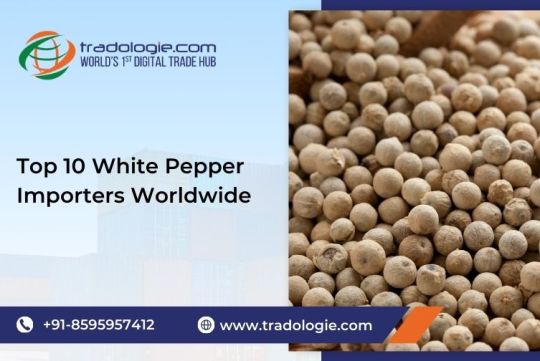
White pepper remains a staple in international kitchens, pharmaceuticals, and food processing, driving strong demand across global markets. With changing consumer preferences and growing spice applications, the top 10 white pepper importers continue to shape trade dynamics.
According to recent global trade data, the top 10 white pepper importing countries are:
United States – The largest importer, with over 7,000 shipments annually.
Ukraine – A growing market, importing approximately 3,400 shipments.
Vietnam – Despite being a top exporter, it also imports white pepper (2,900+ shipments).
Japan – A premium market with 1,750+ shipments.
Singapore – A major re-export hub, handling over 1,600 shipments.
India – High domestic demand leads to 1,500+ imports.
Costa Rica – An emerging importer with 1,300+ shipments.
Germany – A key European market, importing 1,300 shipments.
United Kingdom – Consistent importer with over 1,000 shipments.
Canada – A strong North American market with around 930 shipments.
Through Tradologie.com, importers connect directly with verified white pepper exporters, ensuring transparent pricing, bulk availability, and seamless procurement—making it the ideal platform for expanding into these top importing nations.
#top 10 White Pepper Importers#White Pepper Buyer#White Pepper Seller#Buy Bulk White Pepper#Import and export#agro#agro trade#agro buisness
0 notes
Text
Biggest Banana Exporters: Global Trade Insights 2025
Bananas are one of the most consumed fruits worldwide, making them a crucial part of the global agricultural trade. The banana export industry is dominated by a few key players, with Ecuador, the Philippines, and Guatemala leading the market. In this article, we will explore the biggest banana exporters, banana HS codes, and banana export data, providing valuable insights for businesses looking to enter the banana export market.

Global Banana Industry Overview
The global banana trade was valued at USD 64.06 billion in 2023 and is expected to grow to USD 76.76 billion by 2030. Latin America and the Caribbean remain the dominant regions in banana exports, leveraging their ideal climate and large-scale farming practices.
Key Drivers of the Banana Market:
Increasing demand for organic and fair-trade bananas.
Expansion of global trade networks.
Advancements in cold storage and transportation.
Growing health consciousness among consumers.
Top Banana Producing Countries
The world produces around 135 million metric tonnes of bananas annually. Below are the top banana-producing countries:
India – 30.5 million tonnes
China – 12.1 million tonnes
Indonesia – 7.2 million tonnes
Brazil – 7.0 million tonnes
Ecuador – 6.5 million tonnes
Philippines – 6.4 million tonnes
Guatemala – 3.9 million tonnes
Colombia – 3.5 million tonnes
Thailand – 3.1 million tonnes
Uganda – 2.8 million tonnes
India is the largest producer of bananas globally but ranks only 9th in banana exports due to high domestic consumption.
Global Banana Export Data
The global banana export market saw a 6.7% increase in value from 2022, reaching $14.4 billion in 2023. Here are the biggest banana exporters:
Ecuador – $3.6 billion
Philippines – $1.2 billion
Costa Rica – $1.2 billion
Guatemala – $0.98 billion
Netherlands – $0.91 billion
Colombia – $0.81 billion
United States – $0.49 billion
Germany – $0.31 billion
India – $0.25 billion
Honduras – $0.23 billion
Ecuador dominates the global banana trade, accounting for nearly 25% of total exports. The primary export destinations include the United States, Russia, and Europe.
HS Code for Banana Exports
Understanding banana HS codes is crucial for international trade compliance:
HS Code 08 – Nuts and Edible Fruit
HS Code 0803 – Fresh or dried bananas, including plantains
HS Code 08039010 – Fresh bananas
These classifications help businesses navigate tariffs and trade regulations more effectively.
Major Banana Exporting Companies
Several multinational companies dominate banana exports:
ChiquitaFyffes (Ireland) – 180 million boxes annually
Dole Food Company (USA) – 160 million boxes annually
Favorita Fruit Company (Ecuador) – 120 million boxes annually
Fresh Del Monte Produce (USA) – 110 million boxes annually
Grupo Noboa S.A. (Ecuador) – 90 million boxes annually
These companies control banana production, logistics, and supply chains, ensuring consistent global availability.
Top Destinations for Banana Exports
The following countries are the biggest importers of bananas:
United States – $2.76 billion
Germany – $1.14 billion
China – $1.08 billion
Japan – $0.96 billion
Netherlands – $0.89 billion
The United States is the largest banana importer, followed by Germany and China. These markets drive global banana demand.
Starting a Banana Export Business
For those looking to enter the banana export business, the following steps are essential:
Register Your Business
Obtain an Import Export Code (IEC).
Register with the Food Safety and Standards Authority of India (FSSAI).
Comply with Documentation
Commercial invoice and packing list.
Phytosanitary Certificate for quality assurance.
Certificate of Origin and Bill of Lading.
Identify Potential Markets
Research demand in Middle Eastern, European, and Asian countries.
Partner with importers, supermarkets, and distributors.
Focus on Quality & Packaging
Maintain export-quality bananas by meeting international standards.
Use appropriate packaging to prevent spoilage during transit.
Connect with Buyers & Suppliers
Platforms like Eximpedia.app provide banana export data, helping businesses connect with global buyers and suppliers.
Final Thoughts
The banana export industry remains a lucrative sector with strong global demand. The biggest banana exporters, including Ecuador, the Philippines, and Guatemala, continue to dominate the market, while India holds significant potential for growth.
With the right market insights, trade data, and compliance knowledge, businesses can successfully enter the banana export market and tap into its immense profitability.
For more insights on banana export by country, HS codes, and trade data, connect with Eximpedia.app today!
#BananaExport#BananaTrade#BananaSuppliers#ExportBusiness#GlobalTrade#Eximpedia#AgricultureTrade#BananaExportData
0 notes
Text
Proofing Acoustic Deadening Felt Mass Loaded Recording Studio Sound Vinyl Flooring
Proofing Acoustic Deadening Felt Mass Loaded Recording Studio Sound Vinyl Flooring
MLVinsulation is a professional manufactures working on acoustic products. We can design and manufacture all types of acoustic panels to suit your personal or business needs. MLVinsulation is established in 2011, located in the industrial zone of Baiyun District of Guangzhou. After years of development, the company now covers an area of more than 5000 m2.

MLV Sound Vinyl Mass Loaded Vinyl Acoustic Isolation MLV Noise Barrier Panel Damping Deadening Felt
Our range of products have wide applications such as recording studio, concert theater, exhibition centre, hearing or speech test centers, cinema theatre, audio visual room, tv studio, music and concert auditorium, residential community, stadium renovation project, multipurpose room, etc.
Please, could you provide me with your product catalog, in addition to having special interest in the product Mass loaded vynil (MVF)? I require your data sheet, uses and applications, commercial presentation of the product, price and minimum purchase quantity.
Could any of your staff approach me to facilitate for subjected request? Our company are importers and distributor of acoustic silencing material in Norway.
Our company is building and designs and builds biogas installations. We are interested in your products, especially soundproof mat for floor. We will use it for insulation. What dimensions do you have. And what are your prices?
Over many years experience of manufacturing and exporting to San Jose Costa Rica, Barrie Canada, Derry (Londonderry) United Kingdom, A Coru? a–Oleiros–Arteixo Spain, Albuquerque, Franca Brazil, Krugersdorp South Africa, Lodz Poland, Mogadishu Somalia, Mannheim Germany, Siwan India, Belfast United Kingdom,, we have strict system for quality control and production planning, to guarantee consistent quality.
We practice our belief in human responsibility to our past, present, and future. Website: https://www.mlvinsulation.com/product/mass-loaded-vinyl-stc-27/
1 note
·
View note
Text
fresh grapes EXPORT DATA IN INDIA | fresh grapes EXPORTER IN INDIA | TRADE GENIUS

Trade Exim provide fresh grapes export data in India with details like exporters in India Importer from oversees countries like USA, China, Germany France, Indonesia, Turkey, Thailand, Brazil, Sri Lanka, Argentina, Bolivia, Chile, Columbia, Ecuador, Mexico, Panama, Paraguay, Peru, Uruguay, Venezuela, Costa Rica, Ukraine, Bangladesh, Nepal, Vietnam and Singapore etc with price details including Import duty. (import data for india)
Content of data record are as Bill of Entry Data, H.S Code, Product Description, Value, Quantity, Unit Price in INR & USD , CIF Value, Custom Duty, Foreign Country port and more. (export data)
0 notes
Text
How to find Chile Import Data
If you live in Chile, or if you are a Chilean national living abroad for one year or more and want to import a vehicle into your country of residence, the vehicle must comply with the technical requirements established by the respective authority on imports. In this blog post, we will tell you how to find Chilean customs data.
1. The Chilean Ministry of Public Works and Transportation
The Chilean Ministry of Public Works and Transport (Ministerio de Obras Públicas y Transporte, or MOPT) is the national authority in charge of the technical requirements for imports. This is also the agency you will have to contact to verify that your vehicle complies with the regulations.
Chile import data agency has a secretariat in Santiago and another one in Viña del Mar. In national security, the MOPT is also the agency that takes care of vehicles' registry and owners. The government institution responsible for the registering of vehicles is called "Dirección General de Transporte Terrestre" or DTTR.
2. The DTTR database
The DTTR maintains a database with all vehicles ever registered in Chile since 1970. Please be aware that this database is not open to the general public. You will have to provide your data, including your full name and ID number, to access the information.
Navigate to website and click on Consulta de vehículos
en el Registro Único Nacional.
Type your personal data and click on Consultar.
You will receive the registry results.
Note that you can also search by vehicle plate (vehicle identification number). In this case, type the Vehículo
Identificación Número (VIN), for example: BCH-042-XXXXX.
3. Chile customs data
When you have received the registry results for your vehicle, it is now time to move on and access the data obtained in this way.
If you are a Chilean national living abroad, you must be living more than one year in Chile to access the information concerning your vehicle's importation into the country. You, therefore, need to visit the DTTR secretariat in Santiago or Viña del Mar. This is mandatory if you want to access the data.
4. The DTTR office in Santiago or Viña del Mar
If you are a Chilean national living abroad and want to find out the data concerning your vehicle's importation into Chile, your next step should be to go to one of these two offices, depending on where you live.
Conclusion
If you are a Chilean national living abroad and want to import a vehicle into your country of residence, the vehicle must comply with the technical requirements set forth by the respective authority.
Read a similar article about import export data here at this page.
#global trade data#international trade statistics#argentina trade database#peru export data#chile import data#costa rica export statistics#paraguay import export data
0 notes
Text
Of all member countries in the Organisation for Economic Co-operation and Development (OECD), Belgium was among the few that saw real wages rise and has even led the way when it comes to protecting purchasing power.
Inflation in recent months reached levels not seen for several decades due in particular to the post-Covid recovery and unprecedented energy prices following Russia’s invasion of Ukraine. In October, the inflation rate in Belgium reached 12.27% – the highest since June 1975, while across the OECD, it peaked at an average of 10.7%.
The fact that life became so much more expensive gnawed at residents’ purchasing power in almost all countries, the latest statistics from the OECD showed. Compared with the first quarter of 2022, real wages were on average 3.8% lower in the mostly rich member countries in the first three months of this year.
Not so bad after all
Despite the pick-up in nominal wages, real annual wage growth was negative in 30 of the 34 countries with available data, with an average decline of 3.8%.
"Tensions on labour markets have led to an increase in nominal wages, but this remains below the rate of inflation, resulting in a fall in real wages in the vast majority of OECD sectors and countries," the OECD report read.
But four countries went against the grain and saw real wages (inflation-adjusted) rise. With an increase of 2.9% Belgium was the absolute outlier in this regard, recording the highest increase in wages. Belgium's system of automatic wage indexation has been the primary means of guarding against wage deflation, despite criticisms that the mechanism will trigger spiralling inflation – grave cautions that have yet to transpire.
In an earlier report, the OECD had condemned Belgium's system of government-mandated wage indexations, claiming that it poses one of the "main risks" to the country's economic outlook by potentially inducing "more persistent inflation" and a "consequent loss of export competitiveness."
Another report published in October last year by the Central Economic Council (CEC) also argued that in some sectors, this resulted in Belgian wages being much higher than compared to those in neighbouring economies, which could see companies currently operating in Belgium move abroad where the cost of labour is lower.
In nominal terms, three countries experienced larger wage increases than Belgium (where this rose by 10.1%): Lithuania (+13.6%), Estonia (+11.4%) and Poland (+10.8%), But as inflation was still significantly higher in those countries during the evaluated period, the purchasing power of residents here dropped compared to in Belgium.
Costa Rica (+1.7%), Israel (+0.6%) and the Netherlands (+0.4%) also saw real wages increase, while Hungarians, Latvians and Czechs lost the most in purchasing power due to inflation. Other major Western economies such as the United States, France, the United Kingdom and Germany also saw real wages drop.
The OECD also noted in its study that "corporate profits have risen more than labour costs in many countries and sectors, suggesting that the cost-of-living crisis is not being fairly distributed."
3 notes
·
View notes
Text
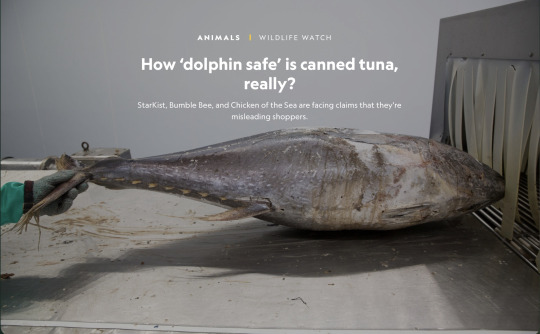
A frozen tuna enters a cleaning machine at the Grupo Pinsa processing plant in Mazatlán, Mexico. Tuna from Mexico is restricted from being sold in the U.S. with a dolphin safe label because some fisheries in the region continue to chase and net dolphins when catching the fish. PHOTOGRAPH BY SUSANA GONZALEZ/BLOOMBERG VIA GETTY IMAGES
— By Rene Ebersole | March 10, 2021 | National Geographic
Jennie Dusheck makes a habit of preparing for the worst. When the California writer realized a few years ago that wildfires and smoke-filled air were becoming an annual inevitability, she bought Israeli gas masks in case it became difficult to breathe. In December 2019, when many West Coasters were looking forward to heavy snow forecasts for skiing, she fretted about the threat of mudslides and wrote an article about how to survive one. With the news of a mysterious disease in China the following February and concerns about food shortages if it spread to the U.S., Dusheck hurried to the grocery store to stock up on staples—pasta, peanut butter, nuts, sardines, tuna.
She felt a little guilty about the tuna, “because there aren’t a lot of fish left in the sea,” she says. “But it was an indulgence that would keep—and I wanted something besides walnuts.”
Of course, Dusheck wasn’t the only pandemic prepper stockpiling tuna. Early on, canned tuna sales doubled. In July 2020, the Wall Street Journal reported that the increased demand for tuna, compounded by pandemic-related port closures and worker quarantines, was challenging some tuna companies to keep up.
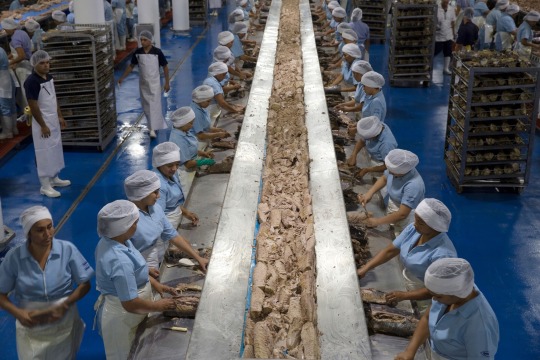
The majority of tuna arrives at processing facilities frozen. After thawing, the fish is steam-baked to allow for easy removal of the skin and bones. Workers seen at the Grupo Pinsa processing plant in Mazatlán, Mexico, are cleaning the meat, which will be cooked a second time before it’s machine-packed in cans. PHOTOGRAPH BY SUSANA GONZALEZ/BLOOMBERG VIA GETTY IMAGES
While the pandemic has been a boon to business, tuna companies have for years struggled with declining sales and perceptions about their product being tainted with toxic mercury, harmful to the environment, and passé with millennials. The newfound popularity of tuna hasn’t freed the longtime staple from controversy, however. The three largest U.S. tuna brands—StarKist, Bumble Bee, and Chicken of the Sea, which collectively account for up to 80 percent of the national market—are facing class action lawsuits claiming that they’re defrauding shoppers with marketing campaigns touting dolphin safety and a commitment to sustainability.
The suits come on the heels of a price fixing scandal involving the big three working together to sell their products at inflated costs. StarKist, acquired by Dongwon Industries in South Korea, pleaded guilty and was fined $100 million. Bumble Bee, recently purchased by the Taiwan seafood conglomerate FCF Co, Ltd., also pleaded guilty and was fined $25 million. The company’s former chief, Christopher Lischewski, who maintained his innocence, is now serving 40 months in a federal prison in Tucson, Arizona. Chicken of the Sea, owned by Bangkok seafood seller Thai Union, was granted amnesty for blowing the whistle on the others.
The dolphin-safe court battle could drag on for years, but it raises important questions for consumers aiming to buy products that are environmentally friendly and socially responsible. (Here’s what the different labels on tuna cans mean.)
“People often see a label on a can and think things are taken care of,” says Ryan Bigelow, senior manager of the Monterey Bay Aquarium’s Seafood Watch program, which makes science-based, sustainable seafood recommendations to grocery shoppers. “The reality is there’s often still a lot more work to be done.”
Gone Fishing
Scientists say there’s one inescapable certainty in any type of commercial fishing: incidental bycatch, the lackluster term for marine life—from whales and dolphins to sharks, seabirds, and endangered sea turtles—unintentionally hooked or ensnared in nets. Fishing methods associated with dolphin bycatch include gillnets, purse seine nets, fish aggregating devices, and longlines.
Each name fittingly describes how the technique works. Gillnets are made of mesh that snags fish by their gills as they swim through it. Purse seine nets encircle schooling fish, which become trapped when the net is cinched, or “pursed,” by a metal cable from the bottom. Often used in combination with purse seines, fish aggregating devices (FADs) are floating rafts attached to a sonar-equipped satellite buoy; they take advantage of the natural tendency for fish to congregate beneath such things as logs drifting in the ocean. Longlines trail up to 50 miles of fishing rope baited with thousands of hooks.
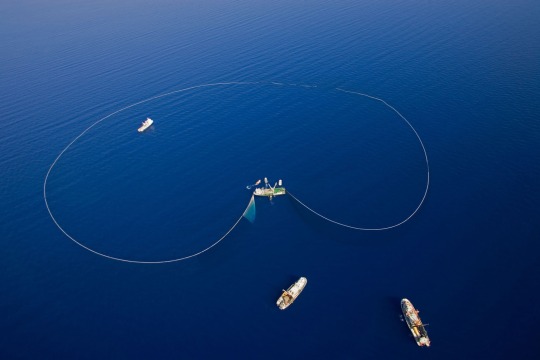
Turkish fishing boats deploy a purse seine net to surround a school of bluefin tuna in the eastern Mediterranean Sea. Bluefin tuna, highly prized for sashimi, are in steep decline from overfishing. Globally, there are 15 species of tuna; albacore, yellowfin, and skipjack are favored for canning. PHOTOGRAPH BY GAVIN NEWMAN, ALAMY STOCK PHOTO
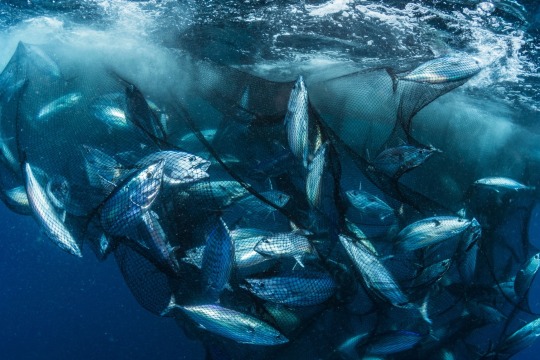
A purse seine net traps a school of skipjack near North Sulawesi, Indonesia. Globally, many tuna fisheries use purse seines, fish aggregating devices (FADs), and longlines—methods that indiscriminately kill dolphins and other marine life as bycatch. When buying canned tuna, choose pole-caught or troll-caught varieties. PHOTOGRAPH BY SHANE GROSS / NPL VIA MINDEN PICTURES
The volume of dolphins and other marine life caught as bycatch from these fishing methods is “staggering,” says Zak Smith, an attorney with the Natural Resources Defense Council who contributed to a 2014 report titled Net Loss: The Killing of Marine Mammals in Foreign Fisheries. The report cites data estimating that 650,000 marine mammals including dolphins, whales, and seals are caught or seriously injured in fisheries every year. “Three hundred thousand of those animals are cetaceans [whales, dolphins, and porpoises],” Smith says, “and the vast majority of them are dolphins because there are a lot more dolphins than anything else.”
The Indian Ocean and the eastern tropical Pacific Ocean—770,000 square miles of blue water and archipelagos off the coast of Ecuador, Panama, Costa Rica, and Columbia— are infamous for dolphin bycatch. In the Indian Ocean, scientists estimate that four million dolphins have died in the region’s poorly regulated gillnet fisheries since the 1950s. The researchers report that roughly 80,000 dolphins are now killed as bycatch annually.
In the tropics of the eastern Pacific Ocean, fishermen have long used dolphin schools as living fish finders, signaling a tuna payload in the deep. This is the only region in the world where a commercial fishery overlaps with the unique, and poorly understood phenomenon of spotted, spinner, and other species of dolphins routinely swimming with schools of yellowfin tuna.
In the old days, seamen chummed the dolphin-rich waters with baitfish, drawing tuna to the surface, where they could hook them with poles. By the late 1950s, however, bait fishermen had widely switched to purse seining, and they commonly targeted and chased the dolphins to corral their tuna catch in the center of nets that could be up to a mile long and 80 feet deep. Scientists estimate that more than six million dolphins were killed by eastern tropical Pacific tuna purse seiners in the three decades before the mid 1990s.
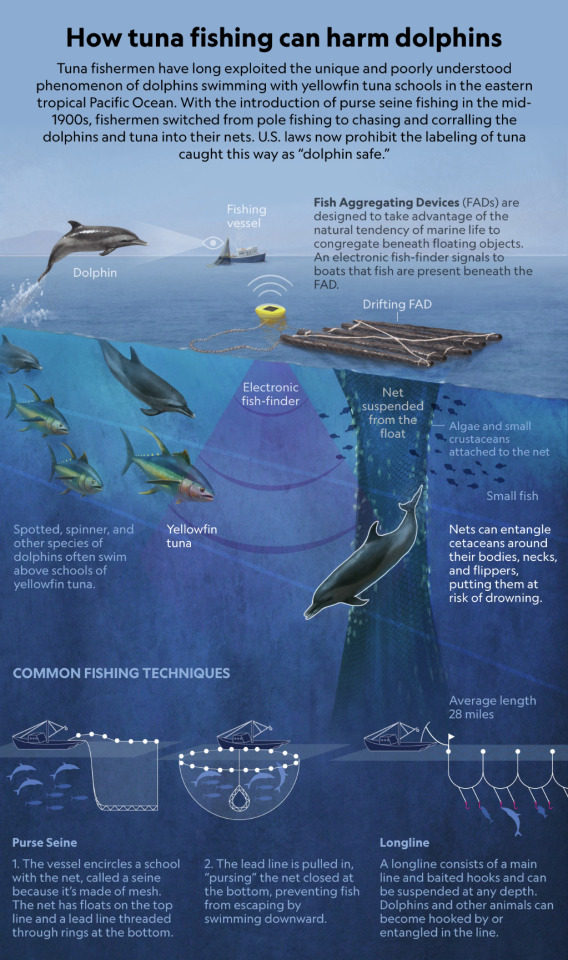
The tipping point came in 1987, when a 31-year-old biologist named Samuel LaBudde (pronounced “LaBuddy”) went undercover as a cook on a Panamanian tuna vessel. On a four-month voyage, he filmed hundreds of dolphins dying as they were hefted from the ocean.
"Drowned or snagged in the net, the dolphins fight a losing battle for life," LaBudde said, narrating the graphic video, broadcast on television and presented before the U.S. Congress. "Some will fall back into the sea as flippers and beaks are broken or ripped out of their bodies, only to become ensnared moments later and be pulled out once again."
Public outrage led to an amendment of the U.S.’s Marine Mammal Protection Act to better protect dolphins and one of the most successful consumer boycotts in national history. “It infected people with a sense of injustice and anger,” LaBudde says. “Thousands of school children refused to eat canned tuna.” In response to the uproar, the big three U.S. tuna companies proclaimed in 1990 that they would not purchase any tuna captured in nets along with dolphins.
Furthermore, the newly signed Dolphin Safe Consumer Information Act of 1990 made it illegal for any tuna product exported from or sold in the U.S. to claim that it’s “dolphin safe” unless it’s in compliance with a bevy of complex U.S. laws and regulations designed to protect dolphins. Demand for dolphin-safe tuna in the U.S. drove many fisheries to adopt the standards, but tuna caught in association with dolphins continues to be sold in Latin America, Asia, and some European countries.
“The U.S. dolphin safe program has been very effective,” says Sara McDonald, a senior fisheries scientist at Monterey Bay Aquarium. “Dolphin mortality in the 1980s was 130,000. In 2018, there were 819 documented deaths. If your product has a dolphin safe label, you are legally obligated not to sell tuna where dolphins were injured, killed, or set upon. It doesn’t mean dolphins aren’t interacting with the tuna fisheries; it means that tuna can’t be sold in this country.”
Accusations of Fraud
The Natural Resources Defense Council’s Smith says he believes that most tuna sold in the U.S. with a dolphin-safe tuna seal is legitimate, but because tuna is a global commodity with very long supply chains, there are opportunities for fraud and deception. “The U.S. laws are good if everyone is being honest,” he says. “But that doesn’t mean nothing ever gets in. There is an incredible amount of illegal wildlife moving into the country. [Law enforcement] can’t catch it all.”
The dolphin-safe tuna class action suits charge that the tuna companies are not being honest about the integrity of their supply chains. More broadly, they allege that the companies have run pervasive advertising campaigns that lead consumers to trust that the companies “never” kill dolphins. For example, the group of people suing Starkist allege that parent company Dongwon’s distant water boats often entrap dolphins, because many are purse-seine fishing vessels that use fish aggregating devices to capture tuna. (Neither purse seine nets nor FADS are banned under U.S. dolphin-safe fishing standards.)
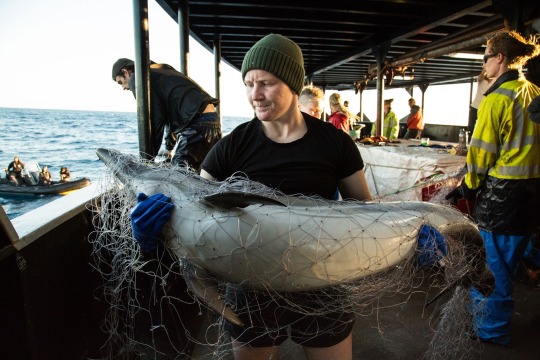
A crew member on the Steve Irwin, the flagship vessel of the conservation nonprofit Sea Shepherd, cradles a common dolphin killed by an illegal drift net in the South Indian Ocean during the group's Operation Driftnet campaign. The UN banned drift nets in 1992 because they kill non-target fish and other wildlife such as sea turtles. PHOTOGRAPH COURTESY OF ELIZA MUIRHEAD / SEA SHEPHERD GLOBAL
“Either the companies should stop accepting tuna from these fishing practices or be up front with consumers that they’re not dolphin safe, even though they may be in compliance with the law,” says Stuart Davidson, one of the lead plaintiff attorneys in the lawsuits. “We want restitution for everyone in the country who paid more than they should have because the tuna was caught with these methods.”
StarKist officials, according to court documents, say it’s unrealistic for consumers to expect that the label means zero harm or injury to dolphins and other wildlife because bycatch is an inescapable reality of any fishery, no matter whether tuna is caught with purse seines or more dolphin-friendly poles—a reality that’s accepted and acknowledged under the Dolphin Protection Consumer Information Act.
Bumble Bee and Chicken of the Sea did not respond to interview requests. A StarKist spokesperson would not comment on the litigation but provided a statement about the company’s commitment to protecting dolphins. “StarKist does not purchase any tuna caught in association with dolphins,” the spokesperson said, and “condemns the use of indiscriminate fishing methods that trap dolphins, whales, and other marine life along with the intended catch of fish.”
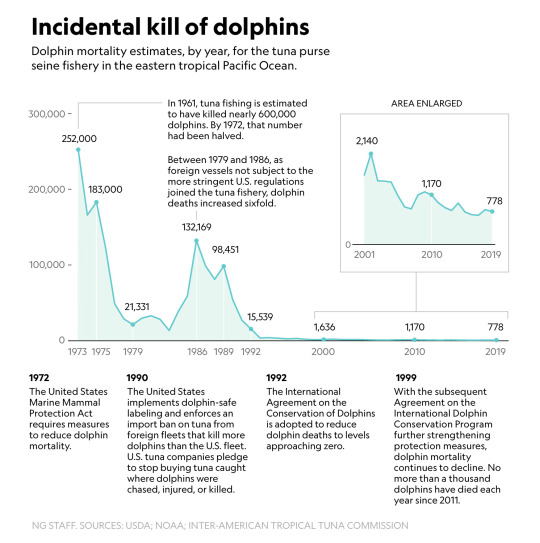
Peeling Back the Labels
As a federal court in California weighs the dolphin-safe lawsuits, sustainable seafood experts offer guidance on how to buy canned tuna that is not only dolphin safe but also environmentally friendly and socially responsible.
“The misconception is if it’s not hurting dolphins, then it must be okay,” says oceans expert and renowned environmental author Carl Safina, who spearheaded a sustainable seafood guide when he was working for the National Audubon Society in the 1990s. “But the reality is it’s likely to be hurting some other non-target species in a big way, or simply depleting the species. The overwhelming majority of tuna populations are overfished.”
Buying sustainable seafood pushes retailers to source environmentally responsible products, which can drive improvements throughout the industry, say Monterey Bay scientists involved with the aquarium’s Seafood Watch consumer guide.
In the case of canned tuna, McDonald says it’s best to read labels for descriptions such as “pole-caught” (fishing one tuna at a time) and “troll-caught” (fished by a slow-moving boat dragging lure lines). “Anything else is less sustainable,” she says. “These fisheries have better control of what they’re catching. There’s also a higher survival rate for the bycatch that they throw back.”
The nonprofit activist group Greenpeace has worked for many years to bring to light the environmental and human rights issues associated with tuna fisheries, including dolphin mortalities, endangered sea turtle and shark bycatch, debt bondage, human trafficking, and forced labor. Taking these factors into account, Greenpeace evaluated the sourcing policies and practices of 20 canned tuna brands and published them in a Tuna Shopping Guide.
StarKist, Chicken of the Sea, and Bumble Bee were among the lowest ranked brands featured in the guide. The four top-rated tuna companies were Wild Planet and American Tuna, which tied for first place, followed by Whole Foods and Ocean Naturals. Selling only pole-caught fish, American Tuna supports local and small-scale fishing and production in the U.S. Wild Planet procures pole- and troll-caught tuna from sustainable fisheries in the U.S., Japan, New Zealand, Spain, Portugal, and the archipelago of Cape Verde off Africa’s northwestern coast.
Shoppers pay a premium—up to six dollars a can—for eco-friendly tuna brands. Wild Planet founder Bill Carvalho says the higher cost is unavoidable because there’s more labor involved with sustainable fishing. “You can’t do this for 59 cents a can,” he says. “Cheap tuna comes at an astronomically high environmental price. They’re dumping endangered species overboard.”
Safina says he tends to avoid eating tuna—with two exceptions. The first is if he catches it himself. “These fish are the most superb animals. When you kill one and turn it into food, it’s precious,” he says. “If you handle it well and use it as sashimi or put it on the grill and cook it just right, it’s just phenomenal.” Second, if it’s pole-caught. “I have a philosophy that it’s good to support the good actors,” he says. “Even if the good actors are within a bad fishery.”
Many consumers are now left with the question of what to do with all the tuna that they stockpiled—Google searches for canned tuna recipes have soared by 300 percent. Writer Jennie Dusheck has no plans to cook tuna lasagna, fish cakes, or noodle casserole. She’s enjoying her “indulgence” with lettuce, red pepper, celery, and lime juice on some good sourdough bread.
2 notes
·
View notes
Text
Caterpillar loss in tropical forest linked to extreme rain, temperature events
https://sciencespies.com/biology/caterpillar-loss-in-tropical-forest-linked-to-extreme-rain-temperature-events/
Caterpillar loss in tropical forest linked to extreme rain, temperature events
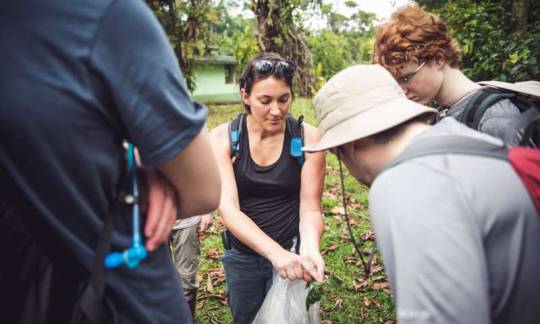

Doctoral candidate Danielle Salcido of the University of Nevada, Reno’s College of Science works with Earthwatch volunteers in Costa Rica, including this team of high school students from Beacon Academy in Chicago, to collect caterpillar, parasite and plant data for research. Credit: University of Nevada, Reno
Using a 22-year dataset of plant-caterpillar-parasitoid interactions collected within a patch of protected Costa Rican lowland Caribbean forest, scientists report declines in caterpillar and parasitoid diversity and density that are paralleled by losses in an important ecosystem service: biocontrol of herbivores by parasitoids.
The study by University of Nevada, Reno researchers, published in Scientific Reports this week, reveals distressing declines among common caterpillar genera and the ecosystem services provided by their natural enemies.
“Declines in herbivore and enemy diversity, as well as parasitism frequency, are partly explained by changes in climate, including increases in extreme precipitation events and increases in mean temperatures,” lead author of the study Danielle Salcido said.
In 2017, the observation by Professor Lee Dyer, of the University’s College of Science, that La Selva Biological Research Station, Costa Rica experienced more frequent flooding events, became the catalyst for a study led by graduate student Salcido to examine patterns in extreme precipitation events and their potential ecological impact for plant-caterpillar-parasitoid interactions in this lowland tropical forest.
“La Selva is an isolated patch of forest surrounded by agriculture that is responsible for global exports of banana, pineapple and palm,” Salcido said. “Habitat patches like La Selva are source populations of parasitoids that control pest populations in surrounding agriculture plantations. Reductions in parasitism by specialized parasitoids threaten this service and ultimately ecosystem health within the forest.”
Along with the help of coauthor and University of Nevada, Reno professor, biologist and butterfly expert Matthew Forister, these researchers found staggering declines in caterpillar and parasitoid diversity and density across the 22 years of the study. More than 40% of the 64 common caterpillar genera collected declined in frequency- a result that suggested the loss of entire groups of caterpillar.
Researchers also found an ecological cost associated with the observed losses. Tandem with declines in diversity, was the reduction in parasitism across years- a natural form of biocontrol and important ecosystem service. Observed declines represented a 30% reduction in parasitism over the next 100-years.
Increased precipitation variability and shifts in mean maximum and minimum temperatures were the most important climate variables associated with declines in diversity.
“We show climate change partially explains the observed declines,” Salcido said. “The variable with largest effect in all models was the effect of time, and indicates the role of unmeasured variables such as surrounding land-use change and pesticide use.”
In the decades prior to the study, much of the forest surrounding La Selva was deforested for pasture which was converted to high-yield, high input plantation farming such that pesticide use increased substantially during the years of the study.
Time-lag effects of extreme climate events were a notable contributor to the reduction in parasitism.
“We found floods in a given year affected parasitism in the subsequent year,” she said. “Caterpillar-parasitoid interactions are intimately linked and depend on narrow windows for synchronous development. Subtle shifts in host and parasitoid population cycles due to variable lag effects can have major consequences for these highly-specialized and synched interactions.”
Declines in insect biodiversity reported in this study come as little surprise amidst a recognized global biodiversity crisis. This study maintains a level of urgency to the matter of insect declines and more importantly, has revealed the vulnerability of the most speciose regions and taxa even within protected habitats, and the role of extreme climate events on ecosystem function.
“This dataset represents one of few of its kind and is notable for the contribution by Earthwatch community scientists,” Salcido said. “Ideally results like ours provide an impetus for policy change that promotes research, conservation and management. In the least, we hope it motivates continued research related to the ecological effects of global change drivers in the tropics.”
The data used for this study is primarily collected by continuous teams of community scientists the scientists bring to the site each year, which highlights the importance of harnessing public participation for the success and longevity of long-term and continuous tropical collection and monitoring.
The Paper in the Nature research journal Scientific Reports, “Loss of dominant caterpillar genera in a protected tropical forest,” was authored by Salcido, Forister, Humberto Garcia-Lopez and Dyer.
Forister and Dyer recently coauthored, with 70 other scientists from around the world, a second paper in the Nature publication Nature Ecology and Evolution titled “International scientists formulate a roadmap for insect conservation and recovery” that is testament to the call-to-action prompted from increased public awareness on insect declines. Their road map to insect conservation and recovery was published this week.
Explore further
New information on tropical parasitoid insects revealed
More information: Danielle M. Salcido et al, Loss of dominant caterpillar genera in a protected tropical forest, Scientific Reports (2020). DOI: 10.1038/s41598-019-57226-9
Provided by University of Nevada, Reno
Citation: Caterpillar loss in tropical forest linked to extreme rain, temperature events (2020, January 22) retrieved 22 January 2020 from https://phys.org/news/2020-01-caterpillar-loss-tropical-forest-linked.html
This document is subject to copyright. Apart from any fair dealing for the purpose of private study or research, no part may be reproduced without the written permission. The content is provided for information purposes only.
#Biology
16 notes
·
View notes
Text
Netflix Will Add Profile Transfer Feature to Account Sharing

Netflix is rolling out a new model that allows account sharers to transfer their profile to a new account. The new "Profile Tranfer" feature lets users to export all the key data in their profile - personalized recommendations, watch list, viewing history, and saved games - into a new account, presumably their own.
In fact, this is not the first attemp of Netflix, which just got hit with two quarters of declining membership numbers, to crack down password sharing. Early in this year Netflix has been experimenting with charged account sharing in Costa Rica, Chile, and Peru, where subscribers were allowed to add two additional members to share an accounts for extra $2.99 per month. In March, they also launched an alternative "add a home" feature, which includes basic, standard, and premium plans with different price, in Argentina, the Dominican Republic, El Salvador, Guatemala, and Honduras.
According to TIME, after years of being relatively laissez-faire about password sharing, Netflix finally started testing ways to "monetize account sharing" after recording its deepest subscriber losses.
But will it work and how effective it will be? “I suspect that a crackdown will result in 5% subscriber growth, partially or fully offset by an increase in churn, and it won‘t impact financials much, if at all,” Wedbush Securities analyst Michael Pachter tells The Hollywood Reporter. Other concerns also raise from Netflix current users. A user explaines that his kids legally use his login at college, and the general crackdown plan angers him for taking away his right of sharing. Nevertheless, Netflix's move indicate a future trend of video streaming services to come up ways to make more profit, and the days of free account sharing are definity soon coming to an end.
0 notes